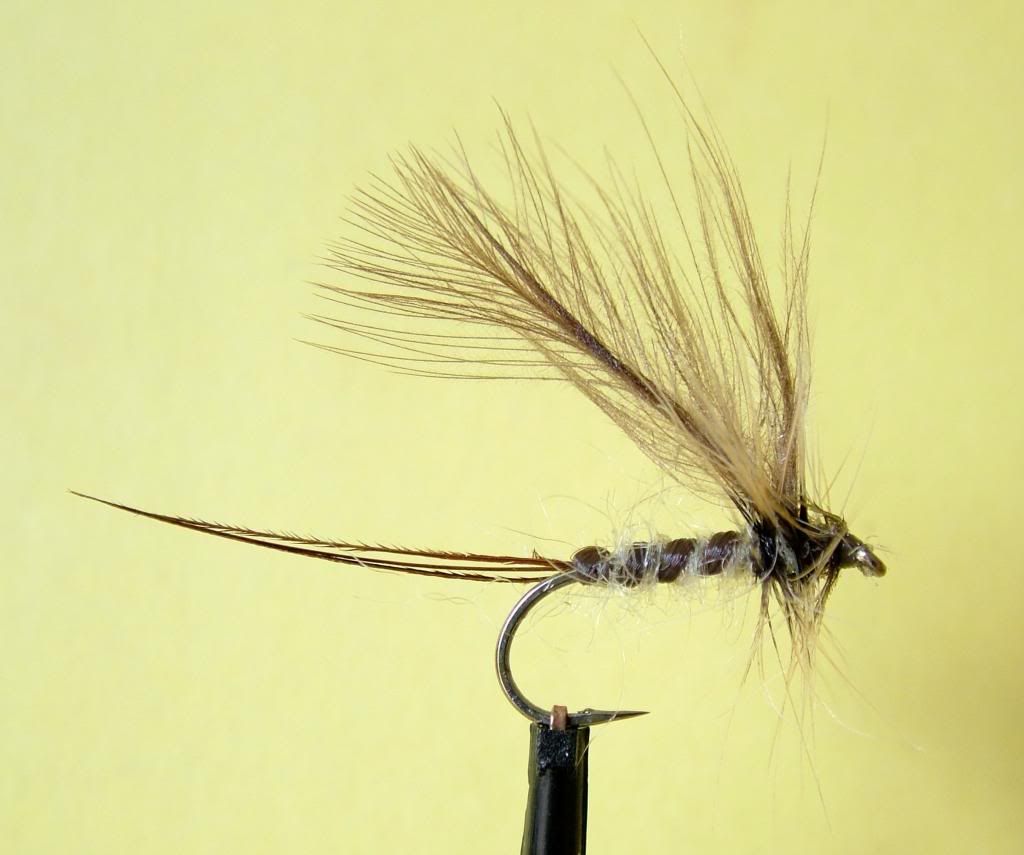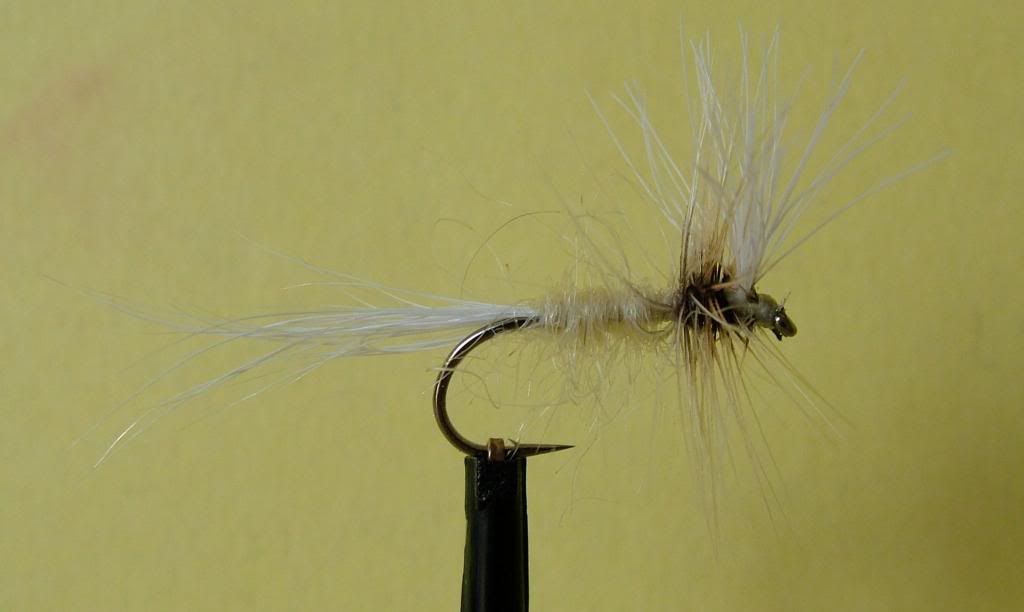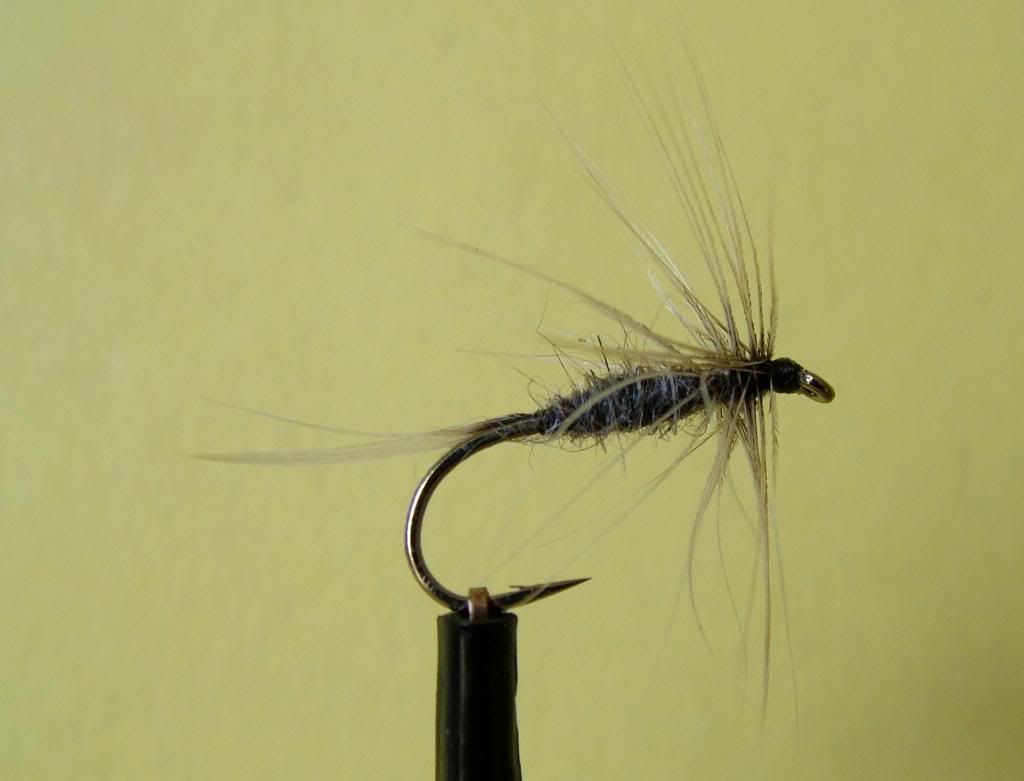This brownie fell to a CDC Mayfly
With the mayfly now upon us - in varying levels of intensity, depending on the geography - I was looking forward to the fishing but, also, to meeting a few of my fellow anglers on the bank. The mayfly season - "duffer's fortnight" - call it what you will, invariably results in an increase in fishers out looking to capitalise on the season's bounty.
I enjoy meeting other fishermen when I'm out. I find it enlightening to hear what they have to say. On more than one occasion I have learned a valuable thing or two as a result of riparian chats with fellow sportsmen. On the Coln last week, one evening after work, I bumped into one and pleasantries were exchanged. He was (as brothers/sisters of the angle invariably are) a thoroughly decent chap. He told me that he had been there for most of the afternoon and that he had caught three fish, all of which had fallen to mayfly imitations but which had been returned as they were "not large". There is minimum size in our club, but I got the impression that his fish had not been below the minimum length; more, that he had judged them too small to kill by his own standard.
After our brief discussion we went on separate courses; he to get a cup of coffee from the flask in his car, I to fish. There were mayfly, but I would not call it a rise. It would be more accurate to say that a steady amount of mayfly were coming off, now and then.
There was a plethora of other fly coming off too; blue winged olives and yellow may dun particularly, but other ephemerids as well. I cast, as is my wont, hither and thither into likely spots. That is what I do when fly is coming off but when there is no significant response. I think that there is a challenge in bringing a fish to the surface that is presumably either nymphing or not hungry. I soon provoked a rise with a CDC Mayfly (see recipe below) from the fish pictured above. An hour and a half later I bumped into the chap again.
"Any joy?" I enquired.
"None", he rejoindered, explaining that he cast only to rising fish using an imitation of the natural. After a brief conversation during which I sheepishly admitted to having used the upstream nymph in the past, he tottered off around the next meander and only when he had disappeared did I recommence fishing.
I would not be so crass as to assume him a card carrying Halfordian - for all I know he had arrived atop his ethical pinnacle after long experience and considered meditation rather than any decision to follow the Great Man's example. There swirled about him, however, a subtle but unmistakeable whiff of disdain at my fishing likely spots without a rise to signify an honourable attempt. For the next couple of hours I caught sight of him, now and then, walking up and down the bank searching in vain for rising fish. I can think of worse ways to spend a beautiful evening by the Coln.
A couple of days later I found myself on the banks of the Windrush near Burford. I wanted to see if the mayfly were any more prolific there than had been the case earlier in the week. The general picture was pretty much as it had been on the Coln. Mayfly, and several other kinds of ephemerids, were coming off the surface steadily enough, but the trout were not interested. It was a beautiful day, the sun was high in a cloudless sky and, as there was nothing much doing and it being so hot, I sat in the shade of a tree and tucked into my lunch. As I ate I watched mayfly after mayfly sail by, or twitch maddeningly in the surface film, or alight from the surface to seek the sanctuary of bank side vegetation. No evidence whatsoever of hungry trout was forthcoming. I set off back downstream to the car not sure whether I would even tie on a fly. I was thinking of travelling on to one of the smaller streams that I am lucky enough to fish, and which I prefer to be beside on days like this.
As I ambled away from the relative cool of the shade of my lunch tree I heard the unmistakeable sound of a trout rising splashily to a mayfly. I turned and watched the ripples spread out across the river as the current pulled them toward me. I tied on a CDC Mayfly while I waited, kneeling, for the fish to rise again, which it did after a about a minute. I counted to sixty and put the fly over the fish, fully expecting an immediate response. However, it was not until the sixth or seventh cast that it rose and took my imitation as flamboyantly as it had the natural. It was a nice fish of good eating proportions but I returned it. For some reason it felt like the right thing to do.
I would not be so crass as to assume him a card carrying Halfordian - for all I know he had arrived atop his ethical pinnacle after long experience and considered meditation rather than any decision to follow the Great Man's example. There swirled about him, however, a subtle but unmistakeable whiff of disdain at my fishing likely spots without a rise to signify an honourable attempt. For the next couple of hours I caught sight of him, now and then, walking up and down the bank searching in vain for rising fish. I can think of worse ways to spend a beautiful evening by the Coln.
A couple of days later I found myself on the banks of the Windrush near Burford. I wanted to see if the mayfly were any more prolific there than had been the case earlier in the week. The general picture was pretty much as it had been on the Coln. Mayfly, and several other kinds of ephemerids, were coming off the surface steadily enough, but the trout were not interested. It was a beautiful day, the sun was high in a cloudless sky and, as there was nothing much doing and it being so hot, I sat in the shade of a tree and tucked into my lunch. As I ate I watched mayfly after mayfly sail by, or twitch maddeningly in the surface film, or alight from the surface to seek the sanctuary of bank side vegetation. No evidence whatsoever of hungry trout was forthcoming. I set off back downstream to the car not sure whether I would even tie on a fly. I was thinking of travelling on to one of the smaller streams that I am lucky enough to fish, and which I prefer to be beside on days like this.
As I ambled away from the relative cool of the shade of my lunch tree I heard the unmistakeable sound of a trout rising splashily to a mayfly. I turned and watched the ripples spread out across the river as the current pulled them toward me. I tied on a CDC Mayfly while I waited, kneeling, for the fish to rise again, which it did after a about a minute. I counted to sixty and put the fly over the fish, fully expecting an immediate response. However, it was not until the sixth or seventh cast that it rose and took my imitation as flamboyantly as it had the natural. It was a nice fish of good eating proportions but I returned it. For some reason it felt like the right thing to do.
A fish of a pound and a bit, also to the CDC Mayfly
FOUR MAYFLY PATTERNS
The recipes below have all produced for me during the mayfly, even the preposterous Green Drake pattern which resembles the natural not one bit. There is a bewildering array of mayfly patterns but I think it's best to choose three or four, tie a few of each and vary it a bit - the CDC Mayfly (my 1st choice, generally) can be tied with spent wings, for instance.
The Grey Wulff is more often fished as a mayfly in the UK than the White, but I find my creamy variation can work well in certain circumstances. It's a good, visible floater in fast water and is an excellent chub fly.
I use the Grey Duster when smaller specimens of Ephemera Danica are coming off. I have found that sometimes the fish will take smaller individuals in preference to the bigger ones, and vice versa of course.
CDC MAYFLY
Hook: Any dry fly or emerger hook, size 10-12
Thread: Cream or Tan
Tail: Three cock pheasant tail fibres
Body: Cream seal's fur
Rib: Brown floss
Wing: Two CDC feathers tied front to front
Hackle: One or two cock badger hackles
Note.
My favourite mayfly imitation. The pictured example is slightly battered from use
GREEN DRAKE
Hook: Any dry fly or emerger hook, size 10-12
Thread: Olive or green
Tail: Three cock pheasant tail fibres, natural or dyed olive
Body: Green Antron
Rib: Fine gold or copper wire
Wings: Green or grey duck flank tied fan style
Hackle: One or two badger cock hackles
WHITE WULFF
Hook: Any dry fly hook, size 10-14
Thread: Tan
Tail: White calf's hair
Body: Cream seal's fur
Hackle: Cock badger
Wing: White calf's hair
Note.
This is my version. Classically, white or black tying thread is used with white dubbing for the body. Use a single bunch of calf's hair for both wing and tail. Separate the wing into two bunches and secure with figure-of-eight turns. A common variation is to tie the wing with a distinct forward tilt.
GREY DUSTER
Hook: Any dry fly hook, size 10-14
Thread: Black or brown
Tail: Cock badger hackle fibres
Body: Blue grey dubbing, ideally rabbit under-fur
Hackle: Cock badger
Note.
Classically tied tail-less - which is fine when tied in smaller sizes as a general or midge pattern. As a mayfly imitation though, a tail is better.
Thread: Black or brown
Tail: Cock badger hackle fibres
Body: Blue grey dubbing, ideally rabbit under-fur
Hackle: Cock badger
Note.
Classically tied tail-less - which is fine when tied in smaller sizes as a general or midge pattern. As a mayfly imitation though, a tail is better.






No comments:
Post a Comment